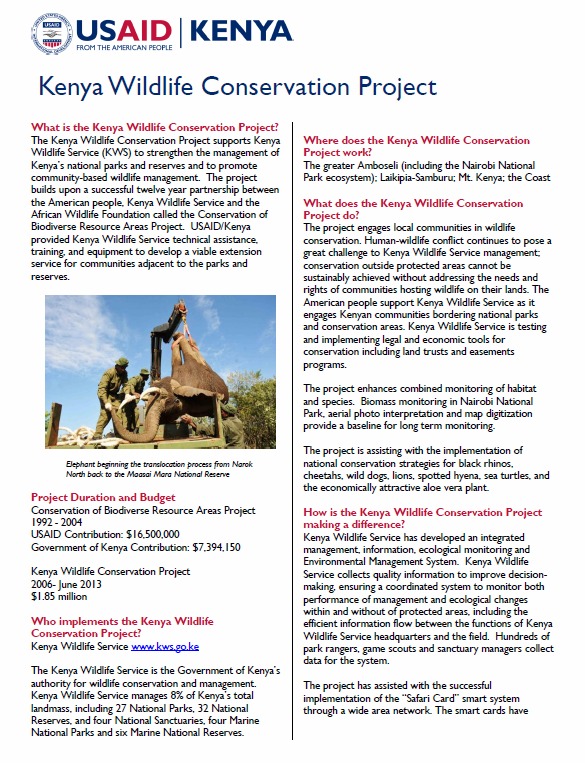What is the Kenya Wildlife Conservation Project?
The Kenya Wildlife Conservation Project supports Kenya Wildlife Service (KWS) to strengthen the management of Kenya’s national parks and reserves and to promote community-based wildlife management. The project builds upon a successful twelve year partnership between the American people, Kenya Wildlife Service and the African Wildlife Foundation called the Conservation of Biodiverse Resource Areas Project. USAID/Kenya provided Kenya Wildlife Service technical assistance, training, and equipment to develop a viable extension service for communities adjacent to the parks and reserves.
Project Duration and Budget
Conservation of Biodiverse Resource Areas Project
1992 - 2004
USAID Contribution: $16,500,000
Government of Kenya Contribution: $7,394,150
Kenya Wildlife Conservation Project
2006- June 2013
$1.85 million
Who implements the Kenya Wildlife Conservation Project?
Kenya Wildlife Service
www.kws.go.ke
The Kenya Wildlife Service is the Government of Kenya’s authority for wildlife conservation and management. Kenya Wildlife Service manages 8% of Kenya’s total landmass, including 27 National Parks, 32 National Reserves, and four National Sanctuaries, four Marine National Parks and six Marine National Reserves.
Where does the Kenya Wildlife Conservation Project work?
The greater Amboseli (including the Nairobi National Park ecosystem); Laikipia-Samburu; Mt. Kenya; the Coast
What does the Kenya Wildlife Conservation Project do?
The project engages local communities in wildlife conservation. Human-wildlife conflict continues to pose a great challenge to Kenya Wildlife Service management; conservation outside protected areas cannot be sustainably achieved without addressing the needs and rights of communities hosting wildlife on their lands. The American people support Kenya Wildlife Service as it engages Kenyan communities bordering national parks and conservation areas. Kenya Wildlife Service is testing and implementing legal and economic tools for conservation including land trusts and easements programs.
The project enhances combined monitoring of habitat and species. Biomass monitoring in Nairobi National Park, aerial photo interpretation and map digitization provide a baseline for long term monitoring.
The project is assisting with the implementation of national conservation strategies for black rhinos, cheetahs, wild dogs, lions, spotted hyena, sea turtles, and the economically attractive aloe vera plant.
How is the Kenya Wildlife Conservation Project making a difference?
Kenya Wildlife Service has developed an integrated management, information, ecological monitoring and Environmental Management System. Kenya Wildlife Service collects quality information to improve decision-making, ensuring a coordinated system to monitor both performance of management and ecological changes within and without of protected areas, including the efficient information flow between the functions of Kenya Wildlife Service headquarters and the field. Hundreds of park rangers, game scouts and sanctuary managers collect data for the system.
The project has assisted with the successful implementation of the “Safari Card” smart system through a wide area network. The smart cards have modernized revenue collection, reducing revenue leakage, and integrated the monitoring system.
In partnership with USAID, Kenya Wildlife Service has implemented the Wildlife Management Information System, a digital monitoring system for reporting and analyzing human-wildlife conflict and poaching incidents and wildlife movements.
Roughly 200 animals have been translocated from community and private sanctuaries to repopulate Meru National Park and expand tourism. Twenty one black rhinos were successfully reintroduced into Ruma National Park in Western Kenya between December 2011 and January 2012, making Ruma the country’s newest Rhino Sanctuary.
What key challenges does the Kenya Wildlife Conservation Project face?
Seventy-five percent of Kenya’s tourism revenue comes from wildlife tourism and yet, Kenya’s abundant natural resources face challenges on diverse fronts. Climate change, habitat degradation and loss, poaching, forest depletion, tourism market volatility, and human-wildlife conflict are threats to preservation and good resource management.
The revised Wildlife Management Policy and Bill, which are critical for sustaining community-based wildlife management in Kenya, are still pending approval.
For more information:
Munira Bashir, Assistant Director/
Head of Community Enterprise
Kenya Wildlife Service
Tel: +254 722 461 412
Email: munira@kws.go.ke
Patrick Omondi, Senior Assistant Director/
Head of Species Conservation and Management
Kenya Wildlife Service
Tel: +254 722 791 718
Email: pomondi@kws.go.ke
Azharul Mazumder, Team Leader
Environment and Natural Resources Management
USAID/Kenya
Tel: + 254 713 601 380
Email: azmazumder@usaid.gov
Updated May 2013








Comment
Make a general inquiry or suggest an improvement.